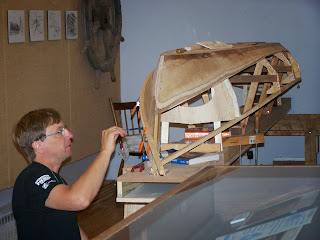Five Weeks at the Colchester Historeum
Before I dive right into talking about my five weeks at the
Colchester Historeum, I want to explain my reasoning in choosing the museum for
my work term. I am graduating from the Business Administration program at the
NSCC Truro Campus in June, 2015. In order to graduate, I needed to complete
certain milestones. One of the milestones was a five week work term and I
wanted to work in a business setting that wasn’t going to be just about
accounting. I thought I’d drive around to see if anything spoke to me and then
I saw the Colchester Historeum. I wasn’t sure if the museum would be a viable
job placement but I thought it wouldn’t hurt to find out. I went in and spoke
to the curator, Jordan Leblanc, and he seemed eager to have me aboard. After
getting approval from Jordan, I had to get approval from the academic board.
After submitting my request it took a day for them to get back to me. They had
had approved the placement. I contacted Jordan immediately to inform him that
everything went well and that I’d be able to start my placement mid April. Now
that all of the background details have been said, let’s get on to the actual
work term.
My experience at the museum is something that will stay with
me for years to come, influencing many of my future decisions. I thought I
would just be doing data entry and cataloguing artifacts but there was much
more to it than that. I had to set up for events, interact with tourists,
direct the public to various locations around the museum, process transactions,
and much more. I was told before that working for a small business and/or a
non-profit organization is completely different than a corporation. I was told
that if I was going to work for a small business and/or organization that I
would have to wear many hats, be excellent at multitasking, and possess great
human relation skills. I thought I had a grasp of what that meant but I was
wrong. I had the smallest understanding of the concept but my time at the
museum has given me a greater appreciation and understanding of what those
courageous and tenacious people have to do daily.
The Colchester Historeum relies on volunteers to help keep
everything running smoothly. All of the volunteers are great people who either
possess a passion for history or possess a passion for community. That is
something I didn’t expect to see when I knew I’d be working here. I simply
thought that the volunteers and employees would be interested in history and
concerned with preserving it for future generations. But they also have a great
sense of community and have many community events at the Colchester Historeum
each year. They have a knit-in, canasta game nights, book sales, and more.
These events happen at least each month and really instill a sense of community
pride. Also, even though I am only going to be working at the museum for five
weeks, I felt that all of the staff took the time to get to know me a little. Most
of them didn’t need to do this since I would hardly, if ever, be called upon to
interact with them but they did it anyway. It felt like I was being welcomed
into a family.
It is now my last week at the museum and I am saying my
goodbyes. Everyone seems interested in my future endeavors and is wishing me
luck. I know that with the knowledge and experience I have gained, I will be
ready for anything. I will truly miss my time spent here. If any students are
reading this and are in need of a work term, I highly recommend the Colchester
Historeum. You’ll never know what to expect and you’ll be tested daily on what
you can handle. It’s a great place to work and an even better place to learn.
by Aaron Pearce


















